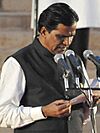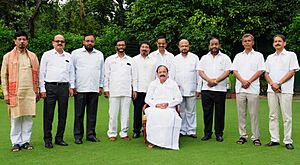Ministry of Mines (India) facts for kids
The Ministry of Mines is a very important part of the Government of India. Think of it as the main team in charge of everything related to mining in India. Its job is to create and manage the rules about how we find and dig up valuable minerals from the ground. The current leader of this ministry is G. Kishan Reddy, who started his role in June 2024.
Branch of Government of India
|
|

Ministry of Mines
|
|
 Minster of Mines - G. Kishan Reddy |
|
| Agency overview | |
|---|---|
| Jurisdiction | Government of India |
| Headquarters | Shastri Bhawan, New Delhi |
| Annual budget | ₹1,669.52 crore (US$280 million) (2018-19 est.) |
| Agency executives |
|
| Website | mines.gov.in |
Contents
What Does the Ministry of Mines Do?
The Ministry of Mines has many important jobs. It looks for and explores different minerals. These include metals like aluminium, copper, zinc, lead, gold, and nickel. They also manage the main law for mines and minerals, called the Mines and Minerals (Development and Regulation) Act of 1957. This law covers all minerals except coal and lignite.
To do all this work, the Ministry has several offices and organizations that help them.
Offices and Organizations
- Attached Office:
- Geological Survey of India: This group is like a detective agency for rocks and minerals. They explore and map out where minerals are found. Their main office is in Kolkata.
- Subordinate Office:
- Indian Bureau of Mines: This office helps make sure mining is done safely and correctly. It's based in Nagpur.
- Public Sector Companies:
These are companies owned by the government that work in the mining sector.
-
- National Aluminium Company Limited (NALCO), Bhubaneswar
- Hindustan Copper Limited (HCL), Kolkata
- Mineral Exploration and Consultancy Limited (MECL), Nagpur
- Independent Organizations:
These groups work on research and development for mining.
-
- Jawaharlal Nehru Aluminium Research Development and Design Centre (JNARDDC), Nagpur
- National Institute of Rock Mechanics (NIRM), Kolar
- National Institute of Miners’ Health (NIMH), Nagpur
- Special Society:
- Non-Ferrous Technology Development Centre
- Centre for Techno Economic Mineral Policy Options (C-TEMPO)
India's Mineral Policy
India has a special plan called the National Mineral Policy. This plan helps guide how minerals are found, mined, and used in the country.
The First Mineral Policy
The first National Mineral Policy was created in 1993. Its main goal was to encourage private companies to invest in mining. It also wanted to bring in new, advanced technology for finding and digging up minerals.
Updating the Policy
Over time, it became clear that there were some problems. It took too long to get permission for mining. Also, there wasn't enough good infrastructure (like roads and facilities) in mining areas.
So, in 2005, a special committee was set up to look into these issues. Based on their suggestions, a new National Mineral Policy was introduced on March 13, 2008.
What the New Policy Does
The National Mineral Policy 2008 changed how the government and states work together. It aims to make it easier for private companies to invest in mining. It also wants to make sure that mining is done fairly and openly. A big part of this policy is making sure that mining is done in a way that protects the environment and helps the local people living near mining areas.
Laws for Mining
The main law that controls mining in India is the Mines and Minerals (Regulation and Development) Act of 1957. This law has been updated many times over the years to keep up with changes in how minerals are developed.
Changes to the Law
Because the old law had been changed so many times, the government decided to create a new one. They wanted it to fit better with the National Mineral Policy of 2008.
A new bill was drafted in 2009-2010. It was designed to make the process of getting mining permits simpler and more open. It also aimed to make sure that money from mining benefits the local communities. This helps them build and improve things like schools and hospitals.
However, after elections in 2014, the new government made more changes. They decided that the only way to get mining permits would be through auctions. This means companies have to bid for the right to mine. Some people in the mining industry worry that this might cause delays and make mining more expensive.
Mining and the Environment
The Ministry of Mines also focuses on "sustainable development." This means mining should be done in a way that doesn't harm the environment and also helps the local communities.
Protecting Nature
The National Mineral Policy 2008 clearly states that mining must be done carefully. It says that mining activities should include ways to restore the environment and balance nature.
It also mentions that mining should not usually happen in areas that are very sensitive ecologically or have a lot of different plants and animals. The goal is to make sure that mining doesn't damage forests, water, air, or land.
Helping Communities
The policy also talks about giving fair compensation to people affected by mining. When a mine closes down, there should be a plan to restore the area. This plan should not only help nature recover but also consider the social and economic needs of the people who live there.
Leaders of the Ministry
Here is a list of the people who have served as the Minister of Mines in India:
| No | Portrait | Name | Term of office | Party | Prime Minister | ||
|---|---|---|---|---|---|---|---|
| 1 |  |
N. V. Gadgil | 15 August 1947 | 26 December 1950 | Indian National Congress | Jawaharlal Nehru | |
| 2 |  |
Swaran Singh | 17 April 1957 | 10 April 1962 | |||
| 3 | Keshav Dev Malviya | 25 April 1957 | 26 June 1963 | ||||
| (2) |  |
Swaran Singh | 26 June 1963 | 19 July 1963 | |||
| 4 |  |
C Subramaniam | 21 November 1963 | 9 June 1964 | Jawaharlal Nehru Gulzari Lal Nanda |
||
| 5 |  |
N. Sanjeeva Reddy | 9 June 1964 | 24 January 1966 | Lal Bahadur Shastri | ||
| 6 | Tribhuvan Narain Singh | 17 January 1967 | 13 March 1969 | Indira Gandhi | |||
| 7 |  |
M. Chenna Reddy | 16 March 1967 | 27 April 1968 | |||
| 8 | Prakash Chandra Sethi (MoS) |
27 April 1968 | 14 February 1969 | ||||
| 9 |  |
Triguna Sen | 14 February 1969 | 18 March 1971 | |||
| 10 | Surendra Mohan Kumaramangalam | 2 May 1971 | 31 May 1973 | ||||
| 11 |  |
Indira Gandhi | 6 June 1973 | 23 July 1973 | |||
| 12 | T. A. Pai | 23 July 1973 | 11 January 1974 | ||||
| (3) | Keshav Dev Malviya | 11 January 1974 | 10 October 1974 | ||||
| 13 | Chandrajit Yadav (MoS) |
10 October 1974 | 24 March 1977 | ||||
| 14 |  |
Biju Patnaik | 26 March 1977 | 15 July 1979 | Janata Party | Morarji Desai | |
| 30 July 1979 | 14 January 1980 | Janata Party (Secular) | Charan Singh | ||||
| 15 |  |
Pranab Mukherjee | 16 January 1980 | 15 January 1982 | Indian National Congress | Indira Gandhi | |
| 16 |  |
N. D. Tiwari | 15 January 1982 | 14 February 1983 | |||
| 17 | N. K. P. Salve (Independent Charge) |
14 February 1983 | 31 December 1984 | Indira Gandhi Rajiv Gandhi |
|||
| 18 | Vasant Sathe | 31 December 1984 | 25 September 1985 | Rajiv Gandhi | |||
| 19 |  |
K. C. Pant | 25 September 1985 | 12 April 1987 | |||
| (18) | Vasant Sathe | 12 April 1987 | 25 July 1987 | ||||
| 20 | M. L. Fotedar | 25 July 1987 | 2 December 1989 | ||||
| 21 | Dinesh Goswami | 6 December 1989 | 10 November 1989 | Asom Gana Parishad | V. P. Singh | ||
| 22 |  |
Ashoke Kumar Sen | 21 November 1990 | 21 June 1991 | Samajwadi Janata Party (Rashtriya) | Chandra Shekhar | |
| 23 | Balram Singh Yadav (Independent Charge) |
21 June 1991 | 15 September 1995 | Indian National Congress | P. V. Narasimha Rao | ||
| 24 |  |
Giridhar Gamang (Independent Charge) |
15 September 1995 | 16 May 1996 | |||
| 25 |  |
Atal Bihari Vajpayee | 16 May 1996 | 1 June 1996 | Bharatiya Janata Party | Atal Bihari Vajpayee | |
| 26 |  |
H. D. Deve Gowda | 1 June 1996 | 29 June 1996 | Janata Dal | H. D. Deve Gowda I. K. Gujral |
|
| 27 | Birendra Prasad Baishya | 29 June 1996 | 19 March 1998 | Asom Gana Parishad (United Front) |
|||
| 28 |  |
Naveen Patnaik | 19 March 1998 | 4 March 2000 | Biju Janata Dal | Atal Bihari Vajpayee | |
| (25) |  |
Atal Bihari Vajpayee | 4 March 2000 | 6 March 2000 | Bharatiya Janata Party | ||
| 29 | P R Kumaramangalam | 6 March 2000 | 27 May 2000 | ||||
| 30 |  |
Sukhdev Singh Dhindsa | 27 May 2000 | 7 November 2000 | Shiromani Akali Dal | ||
| 31 | Sunder Lal Patwa | 7 November 2000 | 1 September 2001 | Bharatiya Janata Party | |||
| 32 |  |
Ram Vilas Paswan | 1 September 2001 | 29 April 2002 | Janata Dal (United) | ||
| (25) |  |
Atal Bihari Vajpayee | 29 April 2002 | 1 July 2002 | Bharatiya Janata Party | ||
| 33 |  |
L. K. Advani | 1 July 2002 | 26 August 2002 | |||
| 34 |  |
Uma Bharati | 26 August 2002 | 29 January 2003 | |||
| 35 |  |
Ramesh Bais (Independent Charge) |
29 January 2003 | 9 January 2004 | |||
| 36 |  |
Mamata Banerjee | 9 January 2004 | 22 May 2004 | All India Trinamool Congress | ||
| 37 |  |
Shibu Soren | 23 May 2004 | 24 July 2004 | Jharkhand Mukti Morcha | Manmohan Singh | |
| 38 |  |
Manmohan Singh | 24 July 2004 | 27 November 2004 | Indian National Congress | ||
| 39 | Sis Ram Ola | 27 November 2004 | 22 May 2009 | ||||
| 40 |  |
Bijoy Krishna Handique | 28 May 2009 | 19 January 2011 | |||
| 41 |  |
Dinsha Patel (Independent Charge till 28 October 2012) |
19 January 2011 | 26 May 2014 | |||
| 42 |  |
Narendra Singh Tomar | 26 May 2014 | 5 July 2016 | Bharatiya Janata Party | Narendra Modi | |
| 43 |  |
Piyush Goyal (Independent Charge) |
5 July 2016 | 3 September 2017 | |||
| (42) |  |
Narendra Singh Tomar | 3 September 2017 | 30 May 2019 | |||
| 44 |  |
Pralhad Joshi | 30 May 2019 | 10 June 2024 | |||
| 45 |  |
G. Kishan Reddy | 10 June 2024 | Incumbent | |||
Ministers of State
The Ministry also has "Ministers of State." These are junior ministers who help the main Minister of Mines with their duties.
| Minister of state | Portrait | Political party | Term | Days | ||
|---|---|---|---|---|---|---|
| Vishnudeo Sai |  |
Bharatiya Janata Party | 26 May 2014 | 5 July 2016 | 2 years, 40 days | |
| Haribhai Parthibhai Chaudhary |  |
3 September 2017 | 30 May 2019 | 1 year, 269 days | ||
| Raosaheb Danve |  |
7 July 2021 | 10 June 2024 | 2 years, 339 days | ||
| Satish Chandra Dubey | 10 June 2024 | Incumbent | 1 year, 189 days | |||


